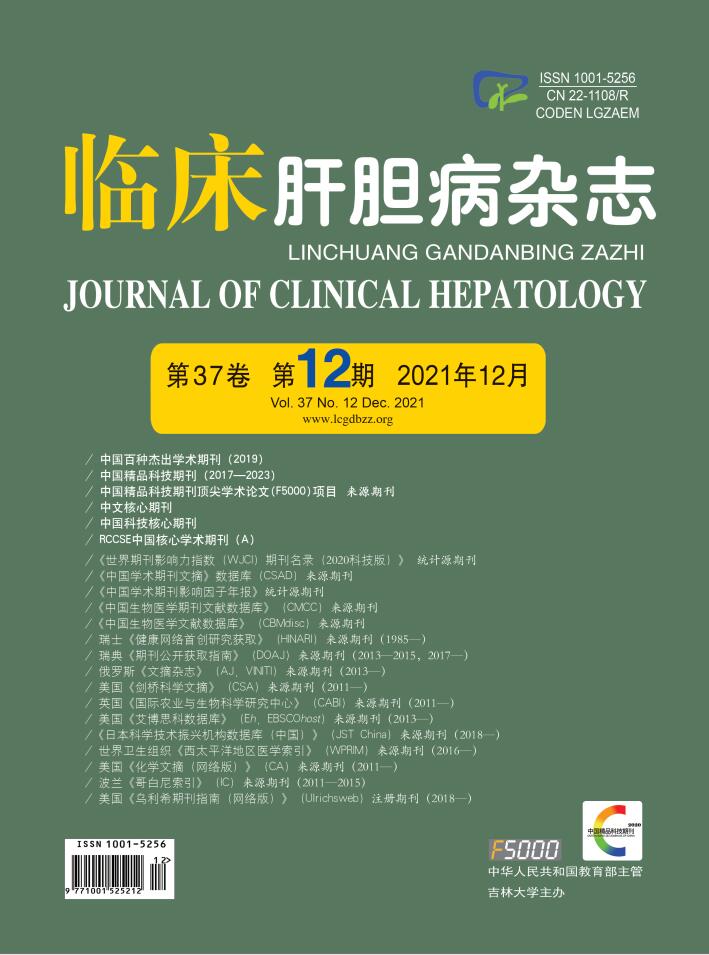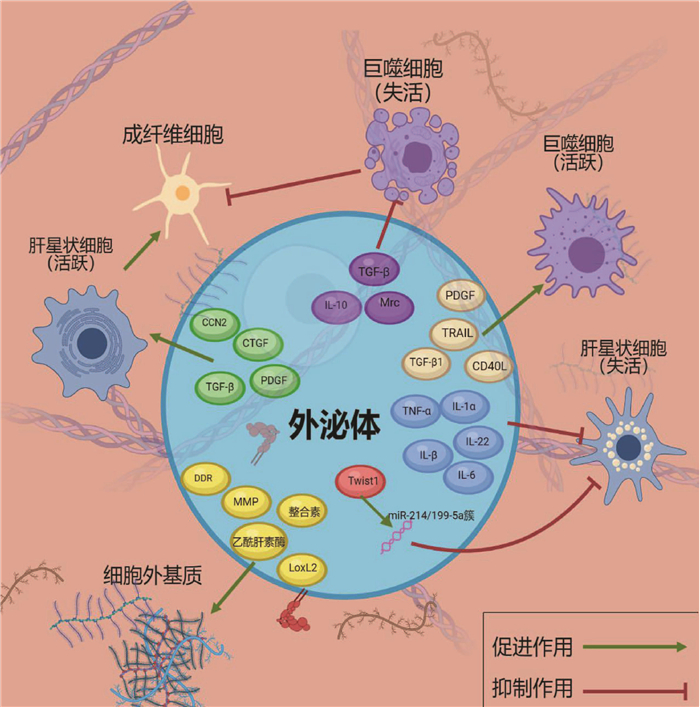| [1] |
DHAR D, BAGLIERI J, KISSELEVA T, et al. Mechanisms of liver fibrosis and its role in liver cancer[J]. Exp Biol Med (Maywood), 2020, 245(2): 96-108. DOI: 10.1177/1535370219898141. |
| [2] |
PAROLA M, PINZANI M. Liver fibrosis: Pathophysiology, pathogenetic targets and clinical issues[J]. Mol Aspects Med, 2019, 65: 37-55. DOI: 10.1016/j.mam.2018.09.002. |
| [3] |
ŠMÍD V. Liver fibrosis[J]. Vnitr Lek, 2020, 66(4): 61-66.
|
| [4] |
ALZHRANI GN, ALANAZI ST, ALSHARIF SY, et al. Exosomes: Isolation, characterization, and biomedical applications[J]. Cell Biol Int, 2021, 45(9): 1807-1831. DOI: 10.1002/cbin.11620. |
| [5] |
ALSHEHRI B. Plant-derived xenomiRs and cancer: Cross-kingdom gene regulation[J]. Saudi J Biol Sci, 2021, 28(4): 2408-2422. DOI: 10.1016/j.sjbs.2021.01.039. |
| [6] |
LIU MY, FU L, ZHANG WH, et al. Progress in mechanism of interaction between immune cells and exosomes[J]. Chin J Immunol, 2019, 35(22): 2806-2812. DOI: 10.3969/j.issn.1000-484X.2019.22.024. |
| [7] |
DEWIDAR B, MEYER C, DOOLEY S, et al. TGF-β in hepatic stellate cell activation and liver fibrogenesis-updated 2019[J]. Cells, 2019, 8(11): 1419. DOI: 10.3390/cells8111419. |
| [8] |
WEISKIRCHEN R, WEISKIRCHEN S, TACKE F. Organ and tissue fibrosis: Molecular signals, cellular mechanisms and translational implications[J]. Mol Aspects Med, 2019, 65: 2-15. DOI: 10.1016/j.mam.2018.06.003. |
| [9] |
FUENTES-CALVO I, MARTINEZ-SALGADO C. Sos1 modulates extracellular matrix synthesis, proliferation, and migration in fibroblasts[J]. Front Physiol, 2021, 12: 645044. DOI: 10.3389/fphys.2021.645044. |
| [10] |
KIM J, KANG W, KANG SH, et al. Proline-rich tyrosine kinase 2 mediates transforming growth factor-beta-induced hepatic stellate cell activation and liver fibrosis[J]. Sci Rep, 2020, 10(1): 21018. DOI: 10.1038/s41598-020-78056-0. |
| [11] |
CHEN PJ, KUO LM, WU YH, et al. BAY 41-2272 attenuates CTGF expression via sGC/cGMP-independent pathway in TGFβ1-activated hepatic stellate cells[J]. Biomedicines, 2020, 8(9): 330. DOI: 10.3390/biomedicines8090330. |
| [12] |
SHAO J, LI S, LIU Y, et al. Extracellular vesicles participate in macrophage-involved immune responses under liver diseases[J]. Life Sci, 2020, 240: 117094. DOI: 10.1016/j.lfs.2019.117094. |
| [13] |
SHEN M, SHEN Y, FAN X, et al. Roles of macrophages and exosomes in liver diseases[J]. Front Med (Lausanne), 2020, 7: 583691. DOI: 10.3389/fmed.2020.583691. |
| [14] |
AN SY, PETRESCU AD, DEMORROW S. Targeting certain interleukins as novel treatment options for liver fibrosis[J]. Front Pharmacol, 2021, 12: 645703. DOI: 10.3389/fphar.2021.645703. |
| [15] |
DEGROOTE H, LEFERE S, VANDIERENDONCK A, et al. Characterization of the inflammatory microenvironment and hepatic macrophage subsets in experimental hepatocellular carcinoma models[J]. Oncotarget, 2021, 12(6): 562-577. DOI: 10.18632/oncotarget.27906. |
| [16] |
ROEHLEN N, CROUCHET E, BAUMERT TF. Liver fibrosis: Mechanistic concepts and therapeutic perspectives[J]. Cells, 2020, 9(4): 875. DOI: 10.3390/cells9040875. |
| [17] |
PINHEIRO D, DIAS I, RIBEIRO SILVA K, et al. Mechanisms underlying cell therapy in liver fibrosis: An overview[J]. Cells, 2019, 8(11): 1339. DOI: 10.3390/cells8111339. |
| [18] |
WANG JP, LI TZ, HUANG XY, et al. Synthesis and anti-fibrotic effects of santamarin derivatives as cytotoxic agents against hepatic stellate cell line LX2[J]. Bioorg Med Chem Lett, 2021, 41: 127994. DOI: 10.1016/j.bmcl.2021.127994. |
| [19] |
SHU Y, LIU X, HUANG H, et al. Research progress of natural compounds in anti-liver fibrosis by affecting autophagy of hepatic stellate cells[J]. Mol Biol Rep, 2021, 48(2): 1915-1924. DOI: 10.1007/s11033-021-06171-w. |
| [20] |
HOFFMANN C, DJERIR N, DANCKAERT A, et al. Hepatic stellate cell hypertrophy is associated with metabolic liver fibrosis[J]. Sci Rep, 2020, 10(1): 3850. DOI: 10.1038/s41598-020-60615-0. |
| [21] |
KHOMICH O, IVANOV AV, BARTOSCH B. Metabolic hallmarks of hepatic stellate cells in liver fibrosis[J]. Cells, 2019, 9(1): 24. DOI: 10.3390/cells9010024. |
| [22] |
CHEN Z, JAIN A, LIU H, et al. Targeted drug delivery to hepatic stellate cells for the treatment of liver fibrosis[J]. J Pharmacol Exp Ther, 2019, 370(3): 695-702. DOI: 10.1124/jpet.118.256156. |
| [23] |
WANG X, SEO W, PARK SH, et al. MicroRNA-223 restricts liver fibrosis by inhibiting the TAZ-IHH-GLI2 and PDGF signaling pathways via the crosstalk of multiple liver cell types[J]. Int J Biol Sci, 2021, 17(4): 1153-1167. DOI: 10.7150/ijbs.58365. |
| [24] |
HAN Z, MA Y, CAO G, et al. Integrin αVβ1 regulates procollagen I production through a non-canonical transforming growth factor β signaling pathway in human hepatic stellate cells[J]. Biochem J, 2021, 478(9): 1689-1703. DOI: 10.1042/BCJ20200749. |
| [25] |
ZENOVIA S, STANCIU C, SFARTI C, et al. Vibration-controlled transient elastography and controlled attenuation parameter for the diagnosis of liver steatosis and fibrosis in patients with nonalcoholic fatty liver disease[J]. Diagnostics (Basel), 2021, 11(5): 787. DOI: 10.3390/diagnostics11050787. |
| [26] |
FLAMINI S, SERGEEV P, VIANA DE BARROS Z, et al. Glucocorticoid-induced leucine zipper regulates liver fibrosis by suppressing CCL2-mediated leukocyte recruitment[J]. Cell Death Dis, 2021, 12(5): 421. DOI: 10.1038/s41419-021-03704-w. |
| [27] |
LIN CY, ADHIKARY P, CHENG K. Cellular protein markers, therapeutics, and drug delivery strategies in the treatment of diabetes-associated liver fibrosis[J]. Adv Drug Deliv Rev, 2021, 174: 127-139. DOI: 10.1016/j.addr.2021.04.008. |
| [28] |
GANTUMUR D, HARIMOTO N, MURANUSHI R, et al. Hepatic stellate cell as a Mac-2-binding protein-producing cell in patients with liver fibrosis[J]. Hepatol Res, 2021. DOI: 10.1111/hepr.13648.[Online ahead of print] |
| [29] |
ZHAO Z, LIN CY, CHENG K. siRNA- and miRNA-based therapeutics for liver fibrosis[J]. Transl Res, 2019, 214: 17-29. DOI: 10.1016/j.trsl.2019.07.007. |
| [30] |
YIN F, WANG WY, JIANG WH. Human umbilical cord mesenchymal stem cells ameliorate liver fibrosis in vitro and in vivo: From biological characteristics to therapeutic mechanisms[J]. World J Stem Cells, 2019, 11(8): 548-564. DOI: 10.4252/wjsc.v11.i8.548. |
| [31] |
LUCANTONI F, MARTÍNEZ-CEREZUELA A, GRUEVSKA A, et al. Understanding the implication of autophagy in the activation of hepatic stellate cells in liver fibrosis: Are we there yet?[J]. J Pathol, 2021, 254(3): 216-228. DOI: 10.1002/path.5678. |
| [32] |
SUN XH, ZHANG H, FAN XP, et al. Astilbin protects against carbon tetrachloride-induced liver fibrosis in rats[J]. Pharmacology, 2021, 106(5-6): 323-331. DOI: 10.1159/000514594. |
| [33] |
WANG L, WANG Y, QUAN J. Exosomes derived from natural killer cells inhibit hepatic stellate cell activation and liver fibrosis[J]. Hum Cell, 2020, 33(3): 582-589. DOI: 10.1007/s13577-020-00371-5. |
| [34] |
GAO J, WEI B, de ASSUNCAO TM, et al. Hepatic stellate cell autophagy inhibits extracellular vesicle release to attenuate liver fibrosis[J]. J Hepatol, 2020, 73(5): 1144-1154. DOI: 10.1016/j.jhep.2020.04.044. |
| [35] |
ZHANG XW, ZHOU JC, PENG D, et al. Disrupting the TRIB3-SQSTM1 interaction reduces liver fibrosis by restoring autophagy and suppressing exosome-mediated HSC activation[J]. Autophagy, 2020, 16(5): 782-796. DOI: 10.1080/15548627.2019.1635383. |
| [36] |
HODGE A, ANDREWARTHA N, LOURENSZ D, et al. Human amnion epithelial cells produce soluble factors that enhance liver repair by reducing fibrosis while maintaining regeneration in a model of chronic liver injury[J]. Cell Transplant, 2020, 29: 963689720950221. DOI: 10.1177/0963689720950221. |
| [37] |
ALATAS FS, MATSUURA T, PUDJIADI AH, et al. Peroxisome proliferator-activated receptor gamma agonist attenuates liver fibrosis by several fibrogenic pathways in an animal model of cholestatic fibrosis[J]. Pediatr Gastroenterol Hepatol Nutr, 2020, 23(4): 346-355. DOI: 10.5223/pghn.2020.23.4.346. |
| [38] |
YANG X, MA L, WEI R, et al. Twist1-induced miR-199a-3p promotes liver fibrosis by suppressing caveolin-2 and activating TGF-β pathway[J]. Signal Transduct Target Ther, 2020, 5(1): 75. DOI: 10.1038/s41392-020-0169-z. |
| [39] |
KISSELEVA T, BRENNER D. Molecular and cellular mechanisms of liver fibrosis and its regression[J]. Nat Rev Gastroenterol Hepatol, 2021, 18(3): 151-166. DOI: 10.1038/s41575-020-00372-7. |
| [40] |
RONG X, LIU J, YAO X, et al. Human bone marrow mesenchymal stem cells-derived exosomes alleviate liver fibrosis through the Wnt/β-catenin pathway[J]. Stem Cell Res Ther, 2019, 10(1): 98. DOI: 10.1186/s13287-019-1204-2. |
| [41] |
WATANABE Y, TSUCHIYA A, SEINO S, et al. Mesenchymal stem cells and induced bone marrow-derived macrophages synergistically improve liver fibrosis in mice[J]. Stem Cells Transl Med, 2019, 8(3): 271-284. DOI: 10.1002/sctm.18-0105. |
| [42] |
CHEN L, CHEN R, KEMPER S, et al. Therapeutic effects of serum extracellular vesicles in liver fibrosis[J]. J Extracell Vesicles, 2018, 7(1): 1461505. DOI: 10.1080/20013078.2018.1461505. |
| [43] |
JIAO Y, XU P, SHI H, et al. Advances on liver cell-derived exosomes in liver diseases[J]. J Cell Mol Med, 2021, 25(1): 15-26. DOI: 10.1111/jcmm.16123. |
| [44] |
CIFERRI MC, QUARTO R, TASSO R. Extracellular vesicles as biomarkers and therapeutic tools: From pre-clinical to clinical applications[J]. Biology (Basel), 2021, 10(5): 359. DOI: 10.3390/biology10050359. |
| [45] |
EUDY BJ, MCDERMOTT CE, LIU X, et al. Targeted and untargeted metabolomics provide insight into the consequences of glycine-N-methyltransferase deficiency including the novel finding of defective immune function[J]. Physiol Rep, 2020, 8(18): e14576. DOI: 10.14814/phy2.14576. |
| [46] |
ZHANG Q, ZHANG Q, LI B, et al. The diagnosis value of a novel model with 5 circulating miRNAs for liver fibrosis in patients with chronic hepatitis B[J]. Mediators Inflamm, 2021, 2021: 6636947. DOI: 10.1155/2021/6636947. |
| [47] |
ZHAO Z, ZHONG L, LI P, et al. Cholesterol impairs hepatocyte lysosomal function causing M1 polarization of macrophages via exosomal miR-122-5p[J]. Exp Cell Res, 2020, 387(1): 111738. DOI: 10.1016/j.yexcr.2019.111738. |
| [48] |
SHEN M, SHEN Y, FAN X, et al. Roles of macrophages and exosomes in liver diseases[J]. Front Med (Lausanne), 2020, 7: 583691. DOI: 10.3389/fmed.2020.583691. |








 DownLoad:
DownLoad:
